Entrepreneurial Strategy for Drink, Shop & Do
VerifiedAdded on 2023/01/19
|11
|3569
|44
AI Summary
This report discusses the entrepreneurial strategy for Drink, Shop & Do, a cafe, bar, and design store in London. It covers the transformation of the business, market analysis, customer orientation, and recommended strategies for growth.
Contribute Materials
Your contribution can guide someone’s learning journey. Share your
documents today.
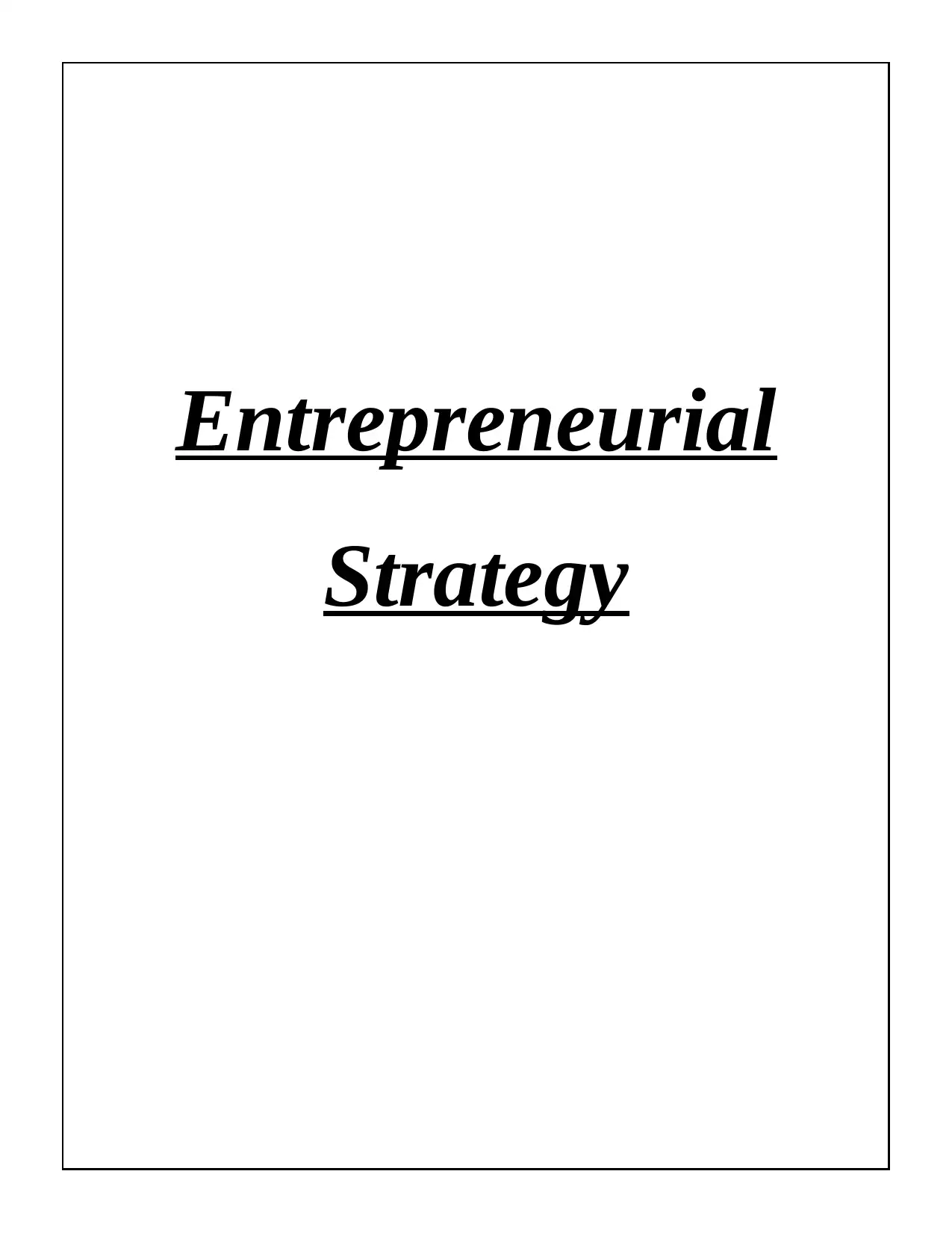
Entrepreneurial
Strategy
Strategy
Secure Best Marks with AI Grader
Need help grading? Try our AI Grader for instant feedback on your assignments.
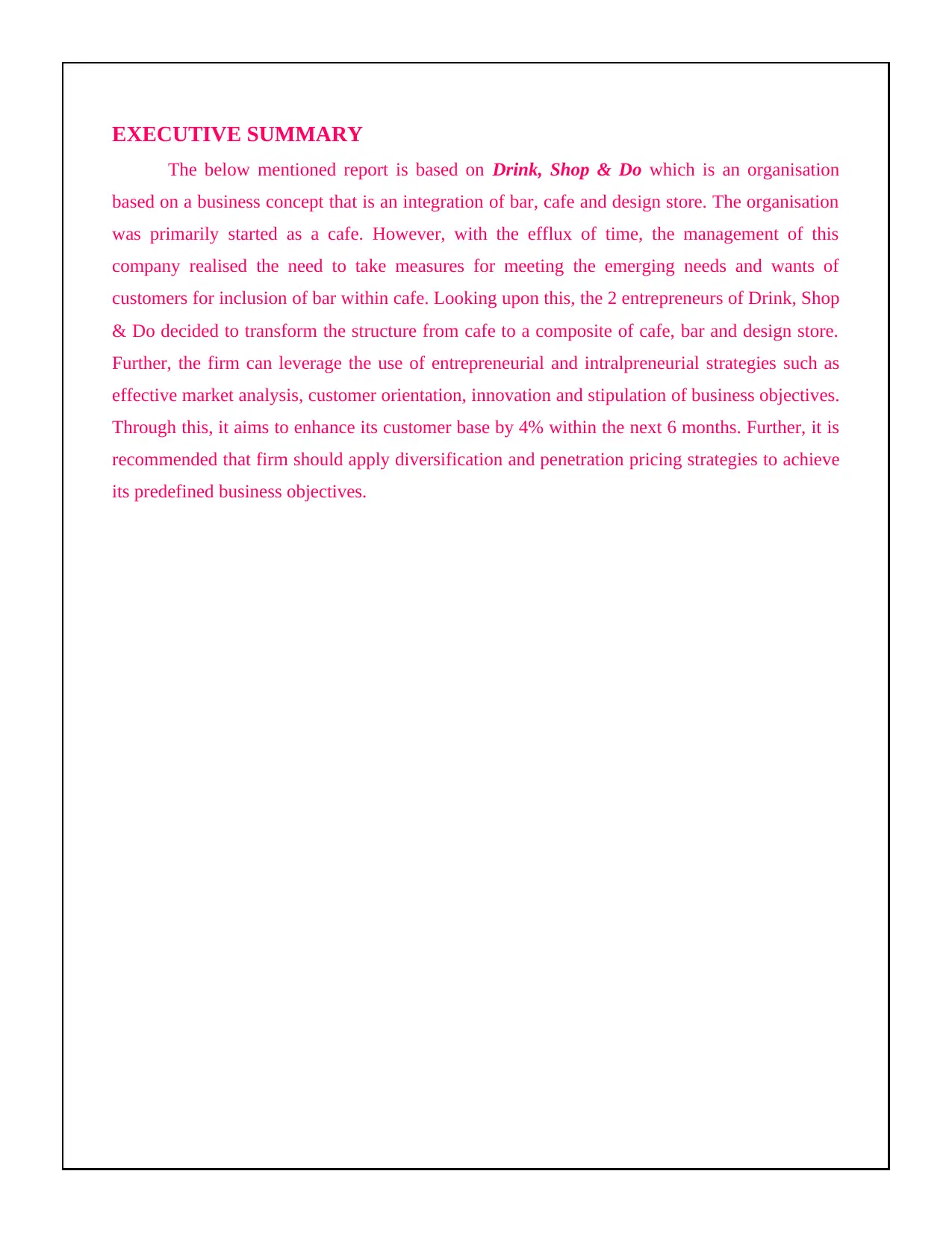
EXECUTIVE SUMMARY
The below mentioned report is based on Drink, Shop & Do which is an organisation
based on a business concept that is an integration of bar, cafe and design store. The organisation
was primarily started as a cafe. However, with the efflux of time, the management of this
company realised the need to take measures for meeting the emerging needs and wants of
customers for inclusion of bar within cafe. Looking upon this, the 2 entrepreneurs of Drink, Shop
& Do decided to transform the structure from cafe to a composite of cafe, bar and design store.
Further, the firm can leverage the use of entrepreneurial and intralpreneurial strategies such as
effective market analysis, customer orientation, innovation and stipulation of business objectives.
Through this, it aims to enhance its customer base by 4% within the next 6 months. Further, it is
recommended that firm should apply diversification and penetration pricing strategies to achieve
its predefined business objectives.
The below mentioned report is based on Drink, Shop & Do which is an organisation
based on a business concept that is an integration of bar, cafe and design store. The organisation
was primarily started as a cafe. However, with the efflux of time, the management of this
company realised the need to take measures for meeting the emerging needs and wants of
customers for inclusion of bar within cafe. Looking upon this, the 2 entrepreneurs of Drink, Shop
& Do decided to transform the structure from cafe to a composite of cafe, bar and design store.
Further, the firm can leverage the use of entrepreneurial and intralpreneurial strategies such as
effective market analysis, customer orientation, innovation and stipulation of business objectives.
Through this, it aims to enhance its customer base by 4% within the next 6 months. Further, it is
recommended that firm should apply diversification and penetration pricing strategies to achieve
its predefined business objectives.
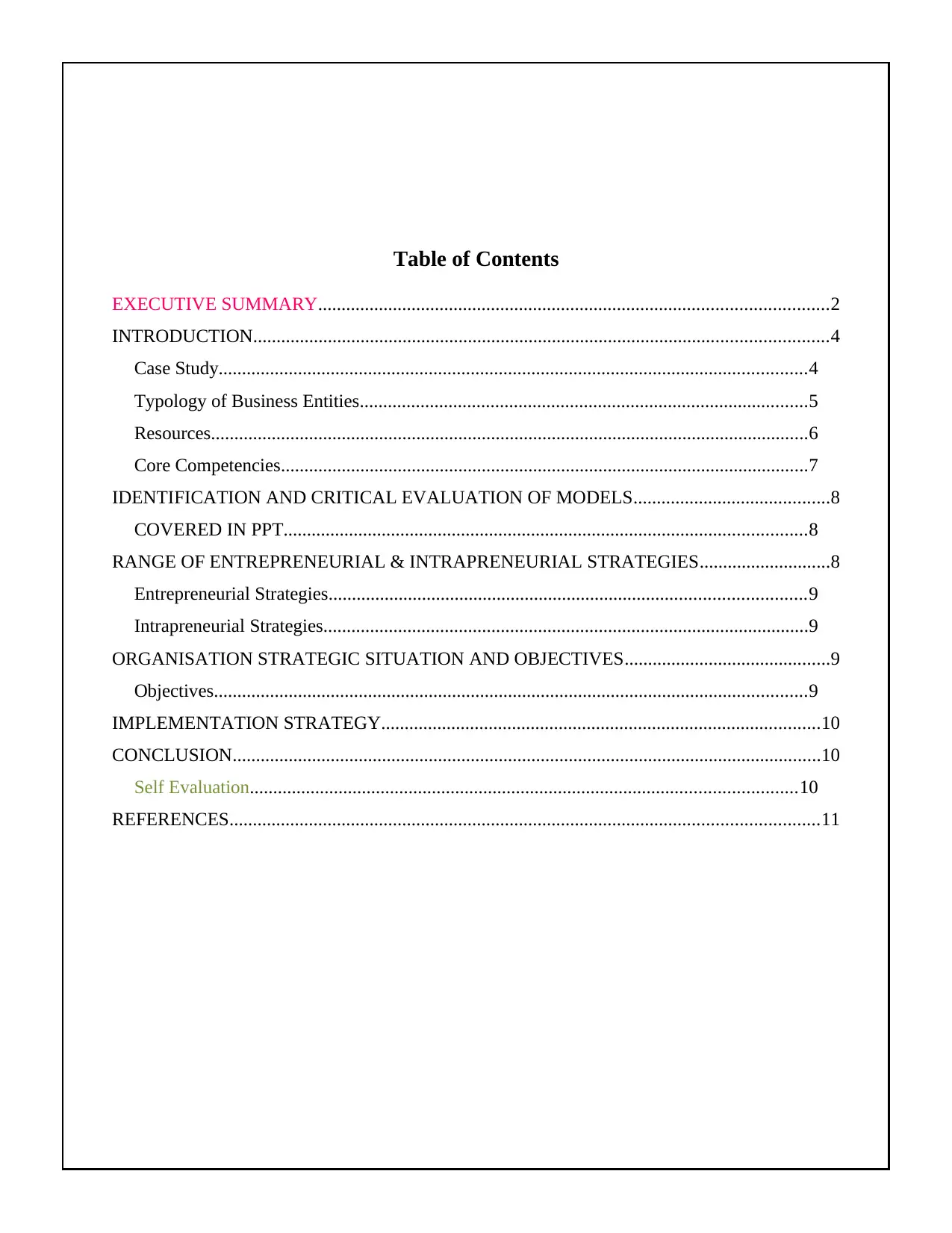
Table of Contents
EXECUTIVE SUMMARY.............................................................................................................2
INTRODUCTION...........................................................................................................................4
Case Study..............................................................................................................................4
Typology of Business Entities................................................................................................5
Resources................................................................................................................................6
Core Competencies.................................................................................................................7
IDENTIFICATION AND CRITICAL EVALUATION OF MODELS..........................................8
COVERED IN PPT................................................................................................................8
RANGE OF ENTREPRENEURIAL & INTRAPRENEURIAL STRATEGIES............................8
Entrepreneurial Strategies......................................................................................................9
Intrapreneurial Strategies........................................................................................................9
ORGANISATION STRATEGIC SITUATION AND OBJECTIVES............................................9
Objectives...............................................................................................................................9
IMPLEMENTATION STRATEGY..............................................................................................10
CONCLUSION..............................................................................................................................10
Self Evaluation.....................................................................................................................10
REFERENCES..............................................................................................................................11
EXECUTIVE SUMMARY.............................................................................................................2
INTRODUCTION...........................................................................................................................4
Case Study..............................................................................................................................4
Typology of Business Entities................................................................................................5
Resources................................................................................................................................6
Core Competencies.................................................................................................................7
IDENTIFICATION AND CRITICAL EVALUATION OF MODELS..........................................8
COVERED IN PPT................................................................................................................8
RANGE OF ENTREPRENEURIAL & INTRAPRENEURIAL STRATEGIES............................8
Entrepreneurial Strategies......................................................................................................9
Intrapreneurial Strategies........................................................................................................9
ORGANISATION STRATEGIC SITUATION AND OBJECTIVES............................................9
Objectives...............................................................................................................................9
IMPLEMENTATION STRATEGY..............................................................................................10
CONCLUSION..............................................................................................................................10
Self Evaluation.....................................................................................................................10
REFERENCES..............................................................................................................................11
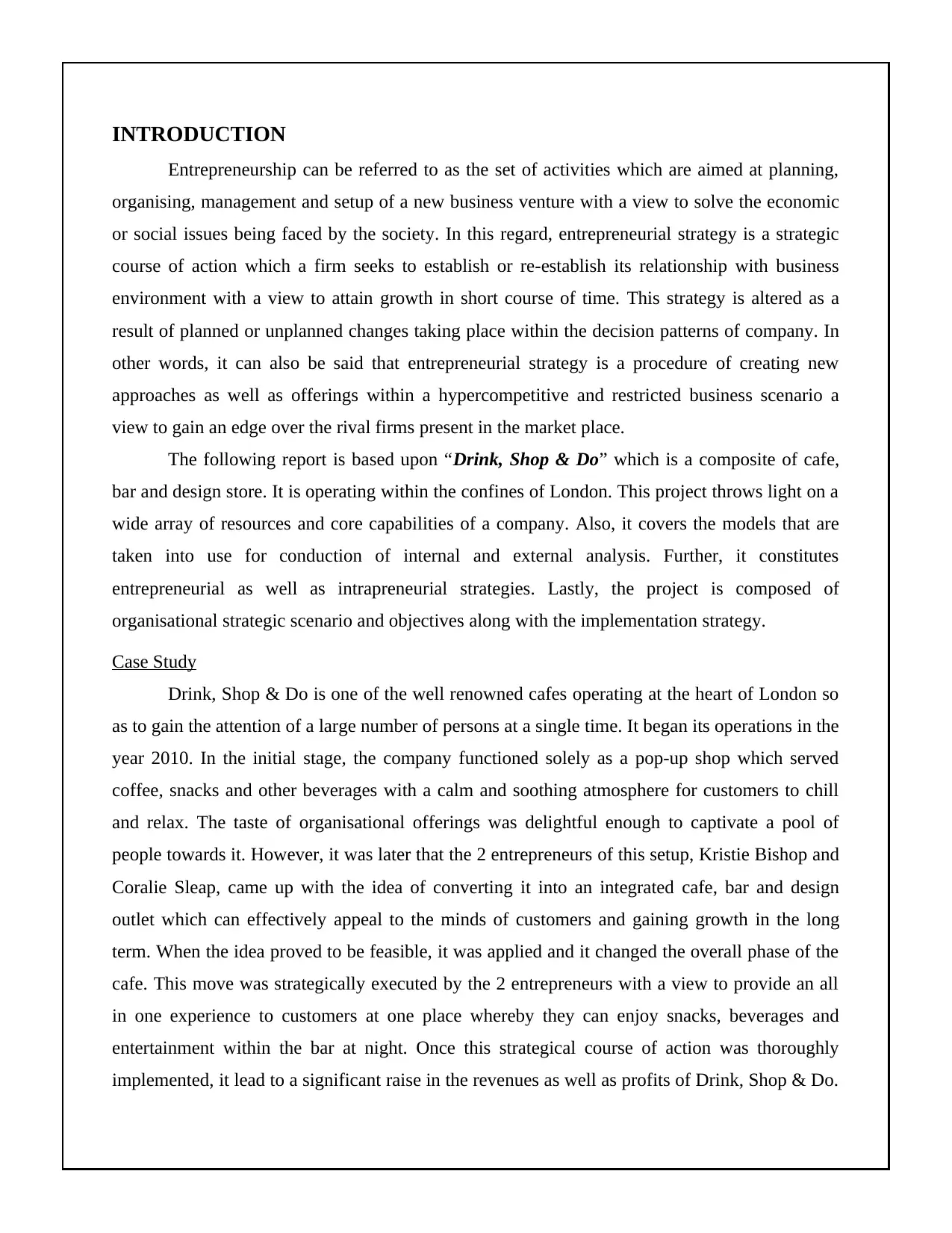
INTRODUCTION
Entrepreneurship can be referred to as the set of activities which are aimed at planning,
organising, management and setup of a new business venture with a view to solve the economic
or social issues being faced by the society. In this regard, entrepreneurial strategy is a strategic
course of action which a firm seeks to establish or re-establish its relationship with business
environment with a view to attain growth in short course of time. This strategy is altered as a
result of planned or unplanned changes taking place within the decision patterns of company. In
other words, it can also be said that entrepreneurial strategy is a procedure of creating new
approaches as well as offerings within a hypercompetitive and restricted business scenario a
view to gain an edge over the rival firms present in the market place.
The following report is based upon “Drink, Shop & Do” which is a composite of cafe,
bar and design store. It is operating within the confines of London. This project throws light on a
wide array of resources and core capabilities of a company. Also, it covers the models that are
taken into use for conduction of internal and external analysis. Further, it constitutes
entrepreneurial as well as intrapreneurial strategies. Lastly, the project is composed of
organisational strategic scenario and objectives along with the implementation strategy.
Case Study
Drink, Shop & Do is one of the well renowned cafes operating at the heart of London so
as to gain the attention of a large number of persons at a single time. It began its operations in the
year 2010. In the initial stage, the company functioned solely as a pop-up shop which served
coffee, snacks and other beverages with a calm and soothing atmosphere for customers to chill
and relax. The taste of organisational offerings was delightful enough to captivate a pool of
people towards it. However, it was later that the 2 entrepreneurs of this setup, Kristie Bishop and
Coralie Sleap, came up with the idea of converting it into an integrated cafe, bar and design
outlet which can effectively appeal to the minds of customers and gaining growth in the long
term. When the idea proved to be feasible, it was applied and it changed the overall phase of the
cafe. This move was strategically executed by the 2 entrepreneurs with a view to provide an all
in one experience to customers at one place whereby they can enjoy snacks, beverages and
entertainment within the bar at night. Once this strategical course of action was thoroughly
implemented, it lead to a significant raise in the revenues as well as profits of Drink, Shop & Do.
Entrepreneurship can be referred to as the set of activities which are aimed at planning,
organising, management and setup of a new business venture with a view to solve the economic
or social issues being faced by the society. In this regard, entrepreneurial strategy is a strategic
course of action which a firm seeks to establish or re-establish its relationship with business
environment with a view to attain growth in short course of time. This strategy is altered as a
result of planned or unplanned changes taking place within the decision patterns of company. In
other words, it can also be said that entrepreneurial strategy is a procedure of creating new
approaches as well as offerings within a hypercompetitive and restricted business scenario a
view to gain an edge over the rival firms present in the market place.
The following report is based upon “Drink, Shop & Do” which is a composite of cafe,
bar and design store. It is operating within the confines of London. This project throws light on a
wide array of resources and core capabilities of a company. Also, it covers the models that are
taken into use for conduction of internal and external analysis. Further, it constitutes
entrepreneurial as well as intrapreneurial strategies. Lastly, the project is composed of
organisational strategic scenario and objectives along with the implementation strategy.
Case Study
Drink, Shop & Do is one of the well renowned cafes operating at the heart of London so
as to gain the attention of a large number of persons at a single time. It began its operations in the
year 2010. In the initial stage, the company functioned solely as a pop-up shop which served
coffee, snacks and other beverages with a calm and soothing atmosphere for customers to chill
and relax. The taste of organisational offerings was delightful enough to captivate a pool of
people towards it. However, it was later that the 2 entrepreneurs of this setup, Kristie Bishop and
Coralie Sleap, came up with the idea of converting it into an integrated cafe, bar and design
outlet which can effectively appeal to the minds of customers and gaining growth in the long
term. When the idea proved to be feasible, it was applied and it changed the overall phase of the
cafe. This move was strategically executed by the 2 entrepreneurs with a view to provide an all
in one experience to customers at one place whereby they can enjoy snacks, beverages and
entertainment within the bar at night. Once this strategical course of action was thoroughly
implemented, it lead to a significant raise in the revenues as well as profits of Drink, Shop & Do.
Secure Best Marks with AI Grader
Need help grading? Try our AI Grader for instant feedback on your assignments.
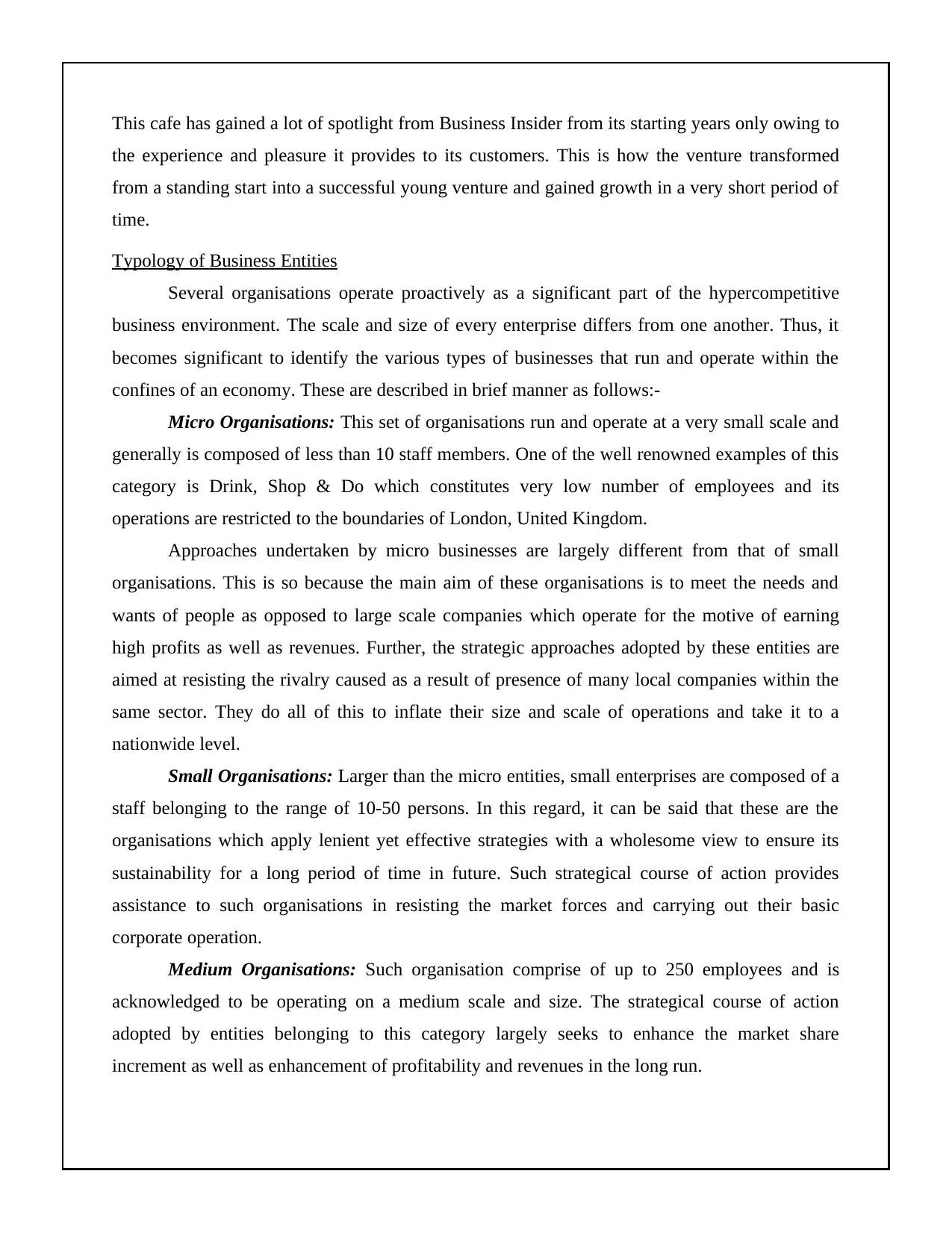
This cafe has gained a lot of spotlight from Business Insider from its starting years only owing to
the experience and pleasure it provides to its customers. This is how the venture transformed
from a standing start into a successful young venture and gained growth in a very short period of
time.
Typology of Business Entities
Several organisations operate proactively as a significant part of the hypercompetitive
business environment. The scale and size of every enterprise differs from one another. Thus, it
becomes significant to identify the various types of businesses that run and operate within the
confines of an economy. These are described in brief manner as follows:-
Micro Organisations: This set of organisations run and operate at a very small scale and
generally is composed of less than 10 staff members. One of the well renowned examples of this
category is Drink, Shop & Do which constitutes very low number of employees and its
operations are restricted to the boundaries of London, United Kingdom.
Approaches undertaken by micro businesses are largely different from that of small
organisations. This is so because the main aim of these organisations is to meet the needs and
wants of people as opposed to large scale companies which operate for the motive of earning
high profits as well as revenues. Further, the strategic approaches adopted by these entities are
aimed at resisting the rivalry caused as a result of presence of many local companies within the
same sector. They do all of this to inflate their size and scale of operations and take it to a
nationwide level.
Small Organisations: Larger than the micro entities, small enterprises are composed of a
staff belonging to the range of 10-50 persons. In this regard, it can be said that these are the
organisations which apply lenient yet effective strategies with a wholesome view to ensure its
sustainability for a long period of time in future. Such strategical course of action provides
assistance to such organisations in resisting the market forces and carrying out their basic
corporate operation.
Medium Organisations: Such organisation comprise of up to 250 employees and is
acknowledged to be operating on a medium scale and size. The strategical course of action
adopted by entities belonging to this category largely seeks to enhance the market share
increment as well as enhancement of profitability and revenues in the long run.
the experience and pleasure it provides to its customers. This is how the venture transformed
from a standing start into a successful young venture and gained growth in a very short period of
time.
Typology of Business Entities
Several organisations operate proactively as a significant part of the hypercompetitive
business environment. The scale and size of every enterprise differs from one another. Thus, it
becomes significant to identify the various types of businesses that run and operate within the
confines of an economy. These are described in brief manner as follows:-
Micro Organisations: This set of organisations run and operate at a very small scale and
generally is composed of less than 10 staff members. One of the well renowned examples of this
category is Drink, Shop & Do which constitutes very low number of employees and its
operations are restricted to the boundaries of London, United Kingdom.
Approaches undertaken by micro businesses are largely different from that of small
organisations. This is so because the main aim of these organisations is to meet the needs and
wants of people as opposed to large scale companies which operate for the motive of earning
high profits as well as revenues. Further, the strategic approaches adopted by these entities are
aimed at resisting the rivalry caused as a result of presence of many local companies within the
same sector. They do all of this to inflate their size and scale of operations and take it to a
nationwide level.
Small Organisations: Larger than the micro entities, small enterprises are composed of a
staff belonging to the range of 10-50 persons. In this regard, it can be said that these are the
organisations which apply lenient yet effective strategies with a wholesome view to ensure its
sustainability for a long period of time in future. Such strategical course of action provides
assistance to such organisations in resisting the market forces and carrying out their basic
corporate operation.
Medium Organisations: Such organisation comprise of up to 250 employees and is
acknowledged to be operating on a medium scale and size. The strategical course of action
adopted by entities belonging to this category largely seeks to enhance the market share
increment as well as enhancement of profitability and revenues in the long run.
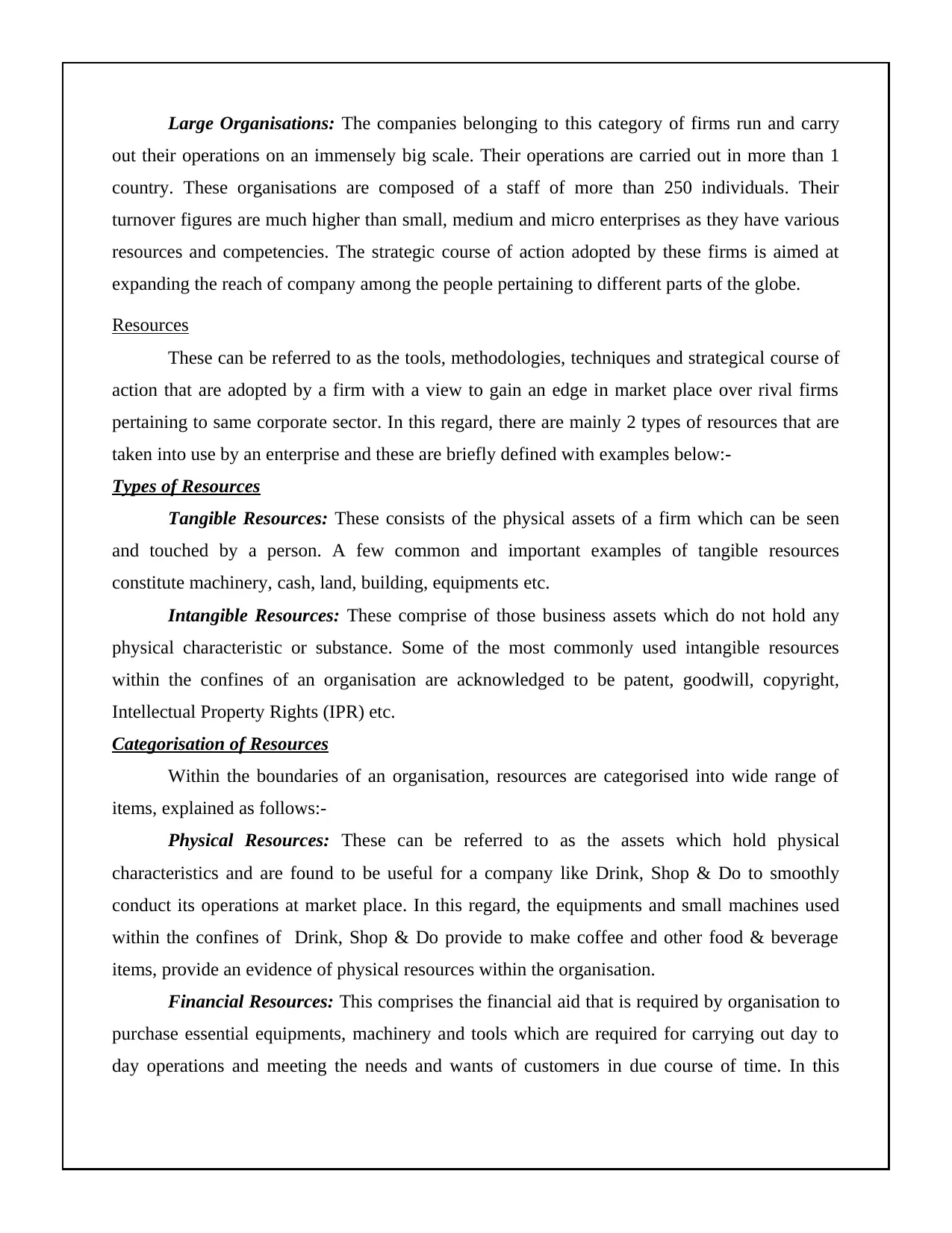
Large Organisations: The companies belonging to this category of firms run and carry
out their operations on an immensely big scale. Their operations are carried out in more than 1
country. These organisations are composed of a staff of more than 250 individuals. Their
turnover figures are much higher than small, medium and micro enterprises as they have various
resources and competencies. The strategic course of action adopted by these firms is aimed at
expanding the reach of company among the people pertaining to different parts of the globe.
Resources
These can be referred to as the tools, methodologies, techniques and strategical course of
action that are adopted by a firm with a view to gain an edge in market place over rival firms
pertaining to same corporate sector. In this regard, there are mainly 2 types of resources that are
taken into use by an enterprise and these are briefly defined with examples below:-
Types of Resources
Tangible Resources: These consists of the physical assets of a firm which can be seen
and touched by a person. A few common and important examples of tangible resources
constitute machinery, cash, land, building, equipments etc.
Intangible Resources: These comprise of those business assets which do not hold any
physical characteristic or substance. Some of the most commonly used intangible resources
within the confines of an organisation are acknowledged to be patent, goodwill, copyright,
Intellectual Property Rights (IPR) etc.
Categorisation of Resources
Within the boundaries of an organisation, resources are categorised into wide range of
items, explained as follows:-
Physical Resources: These can be referred to as the assets which hold physical
characteristics and are found to be useful for a company like Drink, Shop & Do to smoothly
conduct its operations at market place. In this regard, the equipments and small machines used
within the confines of Drink, Shop & Do provide to make coffee and other food & beverage
items, provide an evidence of physical resources within the organisation.
Financial Resources: This comprises the financial aid that is required by organisation to
purchase essential equipments, machinery and tools which are required for carrying out day to
day operations and meeting the needs and wants of customers in due course of time. In this
out their operations on an immensely big scale. Their operations are carried out in more than 1
country. These organisations are composed of a staff of more than 250 individuals. Their
turnover figures are much higher than small, medium and micro enterprises as they have various
resources and competencies. The strategic course of action adopted by these firms is aimed at
expanding the reach of company among the people pertaining to different parts of the globe.
Resources
These can be referred to as the tools, methodologies, techniques and strategical course of
action that are adopted by a firm with a view to gain an edge in market place over rival firms
pertaining to same corporate sector. In this regard, there are mainly 2 types of resources that are
taken into use by an enterprise and these are briefly defined with examples below:-
Types of Resources
Tangible Resources: These consists of the physical assets of a firm which can be seen
and touched by a person. A few common and important examples of tangible resources
constitute machinery, cash, land, building, equipments etc.
Intangible Resources: These comprise of those business assets which do not hold any
physical characteristic or substance. Some of the most commonly used intangible resources
within the confines of an organisation are acknowledged to be patent, goodwill, copyright,
Intellectual Property Rights (IPR) etc.
Categorisation of Resources
Within the boundaries of an organisation, resources are categorised into wide range of
items, explained as follows:-
Physical Resources: These can be referred to as the assets which hold physical
characteristics and are found to be useful for a company like Drink, Shop & Do to smoothly
conduct its operations at market place. In this regard, the equipments and small machines used
within the confines of Drink, Shop & Do provide to make coffee and other food & beverage
items, provide an evidence of physical resources within the organisation.
Financial Resources: This comprises the financial aid that is required by organisation to
purchase essential equipments, machinery and tools which are required for carrying out day to
day operations and meeting the needs and wants of customers in due course of time. In this
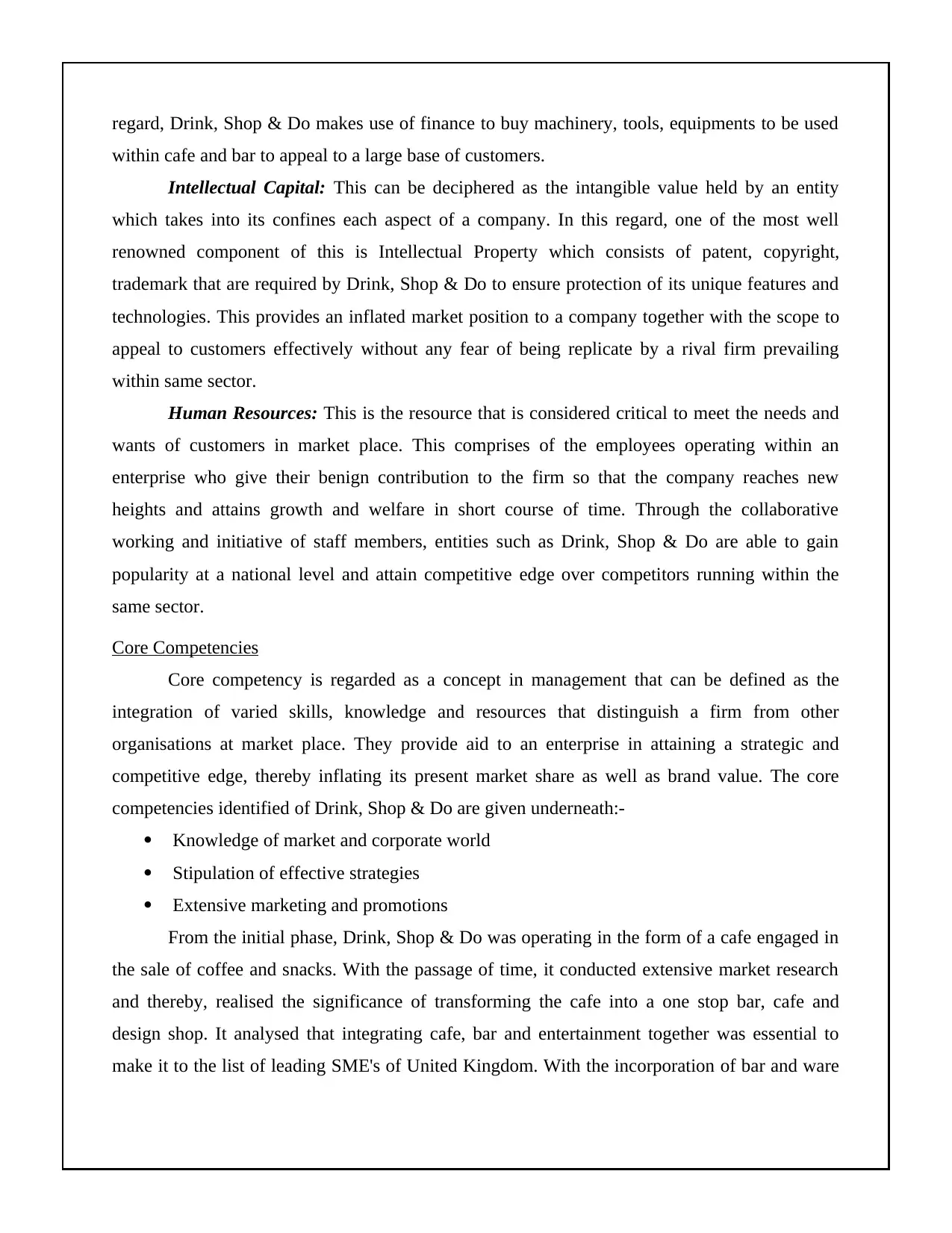
regard, Drink, Shop & Do makes use of finance to buy machinery, tools, equipments to be used
within cafe and bar to appeal to a large base of customers.
Intellectual Capital: This can be deciphered as the intangible value held by an entity
which takes into its confines each aspect of a company. In this regard, one of the most well
renowned component of this is Intellectual Property which consists of patent, copyright,
trademark that are required by Drink, Shop & Do to ensure protection of its unique features and
technologies. This provides an inflated market position to a company together with the scope to
appeal to customers effectively without any fear of being replicate by a rival firm prevailing
within same sector.
Human Resources: This is the resource that is considered critical to meet the needs and
wants of customers in market place. This comprises of the employees operating within an
enterprise who give their benign contribution to the firm so that the company reaches new
heights and attains growth and welfare in short course of time. Through the collaborative
working and initiative of staff members, entities such as Drink, Shop & Do are able to gain
popularity at a national level and attain competitive edge over competitors running within the
same sector.
Core Competencies
Core competency is regarded as a concept in management that can be defined as the
integration of varied skills, knowledge and resources that distinguish a firm from other
organisations at market place. They provide aid to an enterprise in attaining a strategic and
competitive edge, thereby inflating its present market share as well as brand value. The core
competencies identified of Drink, Shop & Do are given underneath:-
Knowledge of market and corporate world
Stipulation of effective strategies
Extensive marketing and promotions
From the initial phase, Drink, Shop & Do was operating in the form of a cafe engaged in
the sale of coffee and snacks. With the passage of time, it conducted extensive market research
and thereby, realised the significance of transforming the cafe into a one stop bar, cafe and
design shop. It analysed that integrating cafe, bar and entertainment together was essential to
make it to the list of leading SME's of United Kingdom. With the incorporation of bar and ware
within cafe and bar to appeal to a large base of customers.
Intellectual Capital: This can be deciphered as the intangible value held by an entity
which takes into its confines each aspect of a company. In this regard, one of the most well
renowned component of this is Intellectual Property which consists of patent, copyright,
trademark that are required by Drink, Shop & Do to ensure protection of its unique features and
technologies. This provides an inflated market position to a company together with the scope to
appeal to customers effectively without any fear of being replicate by a rival firm prevailing
within same sector.
Human Resources: This is the resource that is considered critical to meet the needs and
wants of customers in market place. This comprises of the employees operating within an
enterprise who give their benign contribution to the firm so that the company reaches new
heights and attains growth and welfare in short course of time. Through the collaborative
working and initiative of staff members, entities such as Drink, Shop & Do are able to gain
popularity at a national level and attain competitive edge over competitors running within the
same sector.
Core Competencies
Core competency is regarded as a concept in management that can be defined as the
integration of varied skills, knowledge and resources that distinguish a firm from other
organisations at market place. They provide aid to an enterprise in attaining a strategic and
competitive edge, thereby inflating its present market share as well as brand value. The core
competencies identified of Drink, Shop & Do are given underneath:-
Knowledge of market and corporate world
Stipulation of effective strategies
Extensive marketing and promotions
From the initial phase, Drink, Shop & Do was operating in the form of a cafe engaged in
the sale of coffee and snacks. With the passage of time, it conducted extensive market research
and thereby, realised the significance of transforming the cafe into a one stop bar, cafe and
design shop. It analysed that integrating cafe, bar and entertainment together was essential to
make it to the list of leading SME's of United Kingdom. With the incorporation of bar and ware
Paraphrase This Document
Need a fresh take? Get an instant paraphrase of this document with our AI Paraphraser
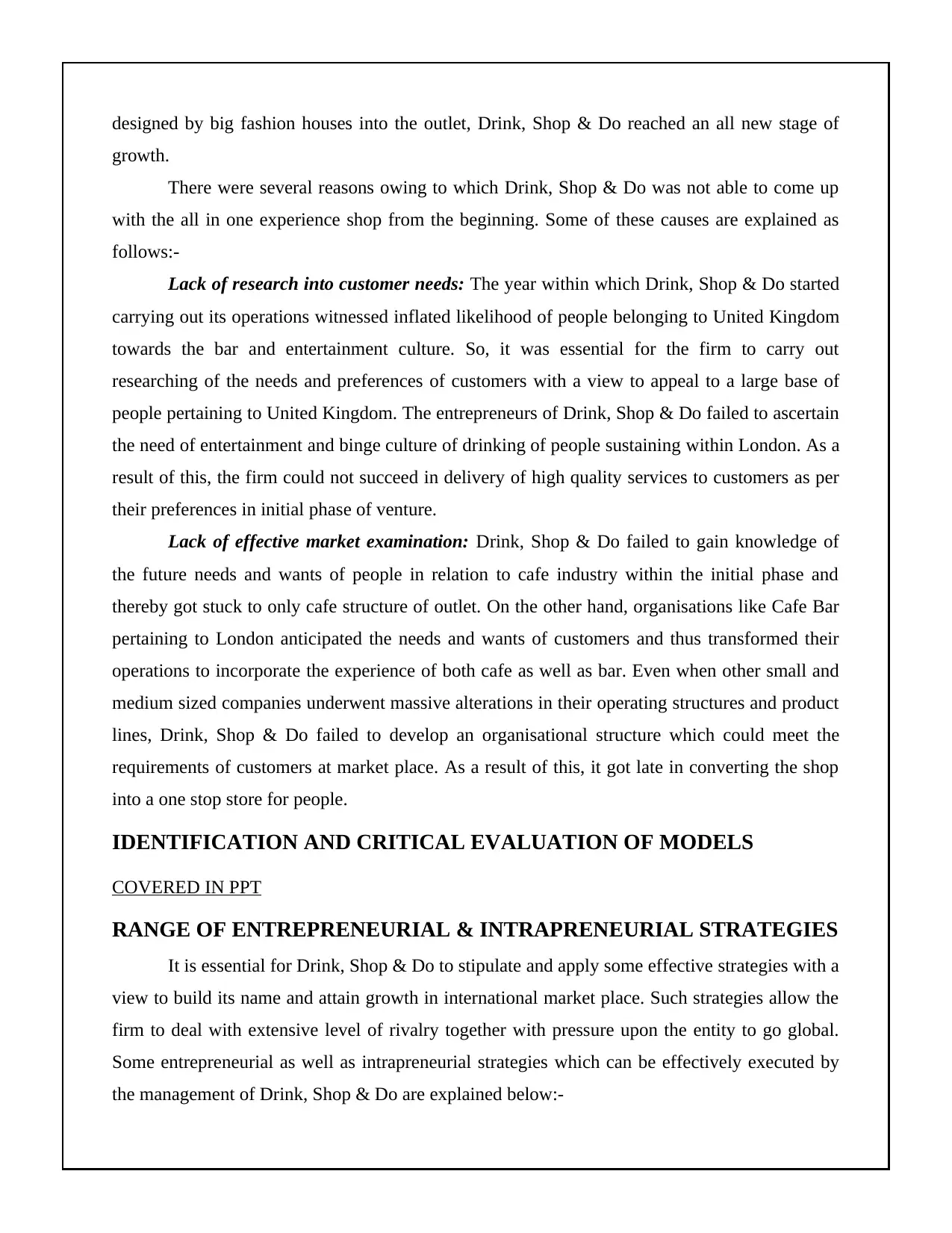
designed by big fashion houses into the outlet, Drink, Shop & Do reached an all new stage of
growth.
There were several reasons owing to which Drink, Shop & Do was not able to come up
with the all in one experience shop from the beginning. Some of these causes are explained as
follows:-
Lack of research into customer needs: The year within which Drink, Shop & Do started
carrying out its operations witnessed inflated likelihood of people belonging to United Kingdom
towards the bar and entertainment culture. So, it was essential for the firm to carry out
researching of the needs and preferences of customers with a view to appeal to a large base of
people pertaining to United Kingdom. The entrepreneurs of Drink, Shop & Do failed to ascertain
the need of entertainment and binge culture of drinking of people sustaining within London. As a
result of this, the firm could not succeed in delivery of high quality services to customers as per
their preferences in initial phase of venture.
Lack of effective market examination: Drink, Shop & Do failed to gain knowledge of
the future needs and wants of people in relation to cafe industry within the initial phase and
thereby got stuck to only cafe structure of outlet. On the other hand, organisations like Cafe Bar
pertaining to London anticipated the needs and wants of customers and thus transformed their
operations to incorporate the experience of both cafe as well as bar. Even when other small and
medium sized companies underwent massive alterations in their operating structures and product
lines, Drink, Shop & Do failed to develop an organisational structure which could meet the
requirements of customers at market place. As a result of this, it got late in converting the shop
into a one stop store for people.
IDENTIFICATION AND CRITICAL EVALUATION OF MODELS
COVERED IN PPT
RANGE OF ENTREPRENEURIAL & INTRAPRENEURIAL STRATEGIES
It is essential for Drink, Shop & Do to stipulate and apply some effective strategies with a
view to build its name and attain growth in international market place. Such strategies allow the
firm to deal with extensive level of rivalry together with pressure upon the entity to go global.
Some entrepreneurial as well as intrapreneurial strategies which can be effectively executed by
the management of Drink, Shop & Do are explained below:-
growth.
There were several reasons owing to which Drink, Shop & Do was not able to come up
with the all in one experience shop from the beginning. Some of these causes are explained as
follows:-
Lack of research into customer needs: The year within which Drink, Shop & Do started
carrying out its operations witnessed inflated likelihood of people belonging to United Kingdom
towards the bar and entertainment culture. So, it was essential for the firm to carry out
researching of the needs and preferences of customers with a view to appeal to a large base of
people pertaining to United Kingdom. The entrepreneurs of Drink, Shop & Do failed to ascertain
the need of entertainment and binge culture of drinking of people sustaining within London. As a
result of this, the firm could not succeed in delivery of high quality services to customers as per
their preferences in initial phase of venture.
Lack of effective market examination: Drink, Shop & Do failed to gain knowledge of
the future needs and wants of people in relation to cafe industry within the initial phase and
thereby got stuck to only cafe structure of outlet. On the other hand, organisations like Cafe Bar
pertaining to London anticipated the needs and wants of customers and thus transformed their
operations to incorporate the experience of both cafe as well as bar. Even when other small and
medium sized companies underwent massive alterations in their operating structures and product
lines, Drink, Shop & Do failed to develop an organisational structure which could meet the
requirements of customers at market place. As a result of this, it got late in converting the shop
into a one stop store for people.
IDENTIFICATION AND CRITICAL EVALUATION OF MODELS
COVERED IN PPT
RANGE OF ENTREPRENEURIAL & INTRAPRENEURIAL STRATEGIES
It is essential for Drink, Shop & Do to stipulate and apply some effective strategies with a
view to build its name and attain growth in international market place. Such strategies allow the
firm to deal with extensive level of rivalry together with pressure upon the entity to go global.
Some entrepreneurial as well as intrapreneurial strategies which can be effectively executed by
the management of Drink, Shop & Do are explained below:-
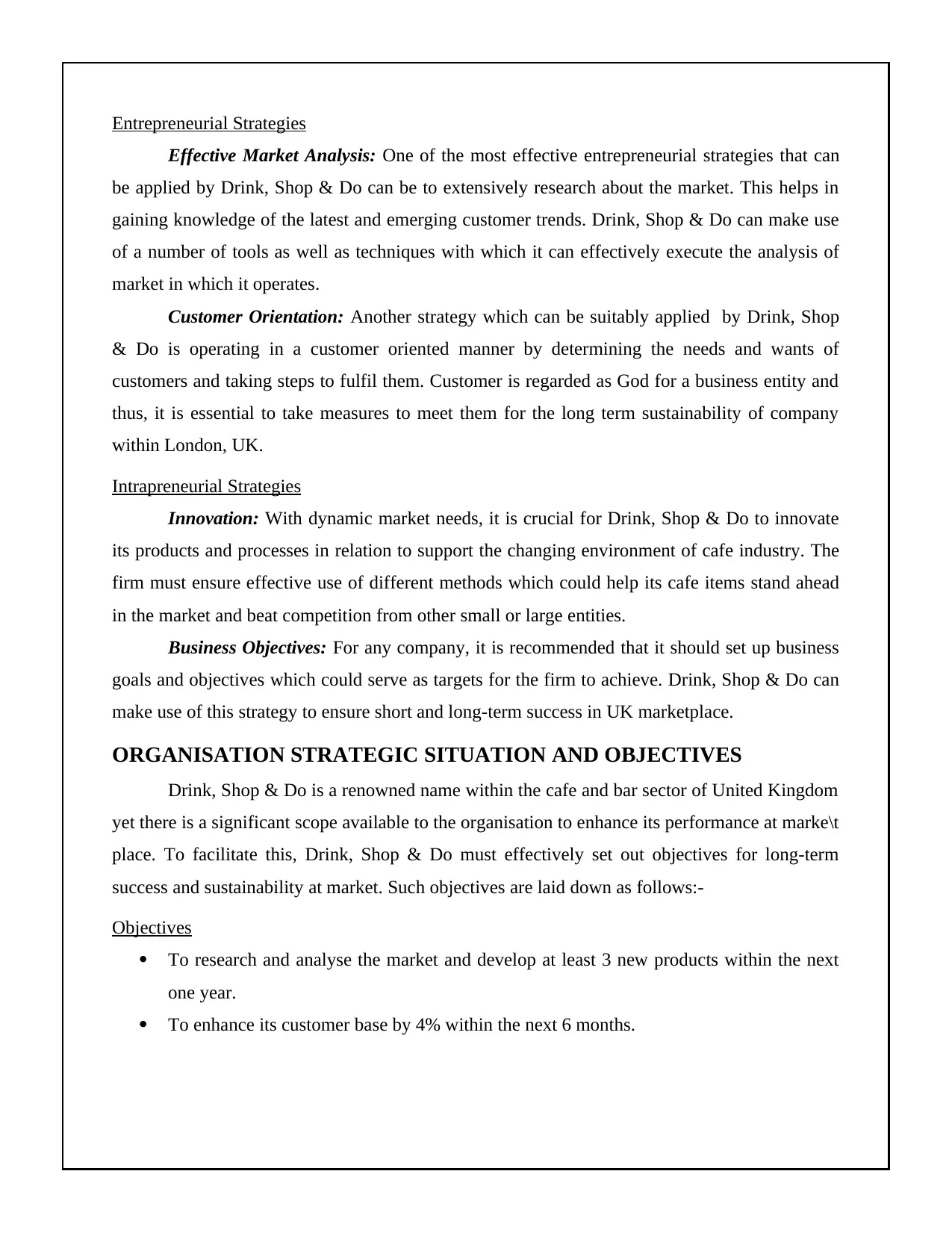
Entrepreneurial Strategies
Effective Market Analysis: One of the most effective entrepreneurial strategies that can
be applied by Drink, Shop & Do can be to extensively research about the market. This helps in
gaining knowledge of the latest and emerging customer trends. Drink, Shop & Do can make use
of a number of tools as well as techniques with which it can effectively execute the analysis of
market in which it operates.
Customer Orientation: Another strategy which can be suitably applied by Drink, Shop
& Do is operating in a customer oriented manner by determining the needs and wants of
customers and taking steps to fulfil them. Customer is regarded as God for a business entity and
thus, it is essential to take measures to meet them for the long term sustainability of company
within London, UK.
Intrapreneurial Strategies
Innovation: With dynamic market needs, it is crucial for Drink, Shop & Do to innovate
its products and processes in relation to support the changing environment of cafe industry. The
firm must ensure effective use of different methods which could help its cafe items stand ahead
in the market and beat competition from other small or large entities.
Business Objectives: For any company, it is recommended that it should set up business
goals and objectives which could serve as targets for the firm to achieve. Drink, Shop & Do can
make use of this strategy to ensure short and long-term success in UK marketplace.
ORGANISATION STRATEGIC SITUATION AND OBJECTIVES
Drink, Shop & Do is a renowned name within the cafe and bar sector of United Kingdom
yet there is a significant scope available to the organisation to enhance its performance at marke\t
place. To facilitate this, Drink, Shop & Do must effectively set out objectives for long-term
success and sustainability at market. Such objectives are laid down as follows:-
Objectives
To research and analyse the market and develop at least 3 new products within the next
one year.
To enhance its customer base by 4% within the next 6 months.
Effective Market Analysis: One of the most effective entrepreneurial strategies that can
be applied by Drink, Shop & Do can be to extensively research about the market. This helps in
gaining knowledge of the latest and emerging customer trends. Drink, Shop & Do can make use
of a number of tools as well as techniques with which it can effectively execute the analysis of
market in which it operates.
Customer Orientation: Another strategy which can be suitably applied by Drink, Shop
& Do is operating in a customer oriented manner by determining the needs and wants of
customers and taking steps to fulfil them. Customer is regarded as God for a business entity and
thus, it is essential to take measures to meet them for the long term sustainability of company
within London, UK.
Intrapreneurial Strategies
Innovation: With dynamic market needs, it is crucial for Drink, Shop & Do to innovate
its products and processes in relation to support the changing environment of cafe industry. The
firm must ensure effective use of different methods which could help its cafe items stand ahead
in the market and beat competition from other small or large entities.
Business Objectives: For any company, it is recommended that it should set up business
goals and objectives which could serve as targets for the firm to achieve. Drink, Shop & Do can
make use of this strategy to ensure short and long-term success in UK marketplace.
ORGANISATION STRATEGIC SITUATION AND OBJECTIVES
Drink, Shop & Do is a renowned name within the cafe and bar sector of United Kingdom
yet there is a significant scope available to the organisation to enhance its performance at marke\t
place. To facilitate this, Drink, Shop & Do must effectively set out objectives for long-term
success and sustainability at market. Such objectives are laid down as follows:-
Objectives
To research and analyse the market and develop at least 3 new products within the next
one year.
To enhance its customer base by 4% within the next 6 months.
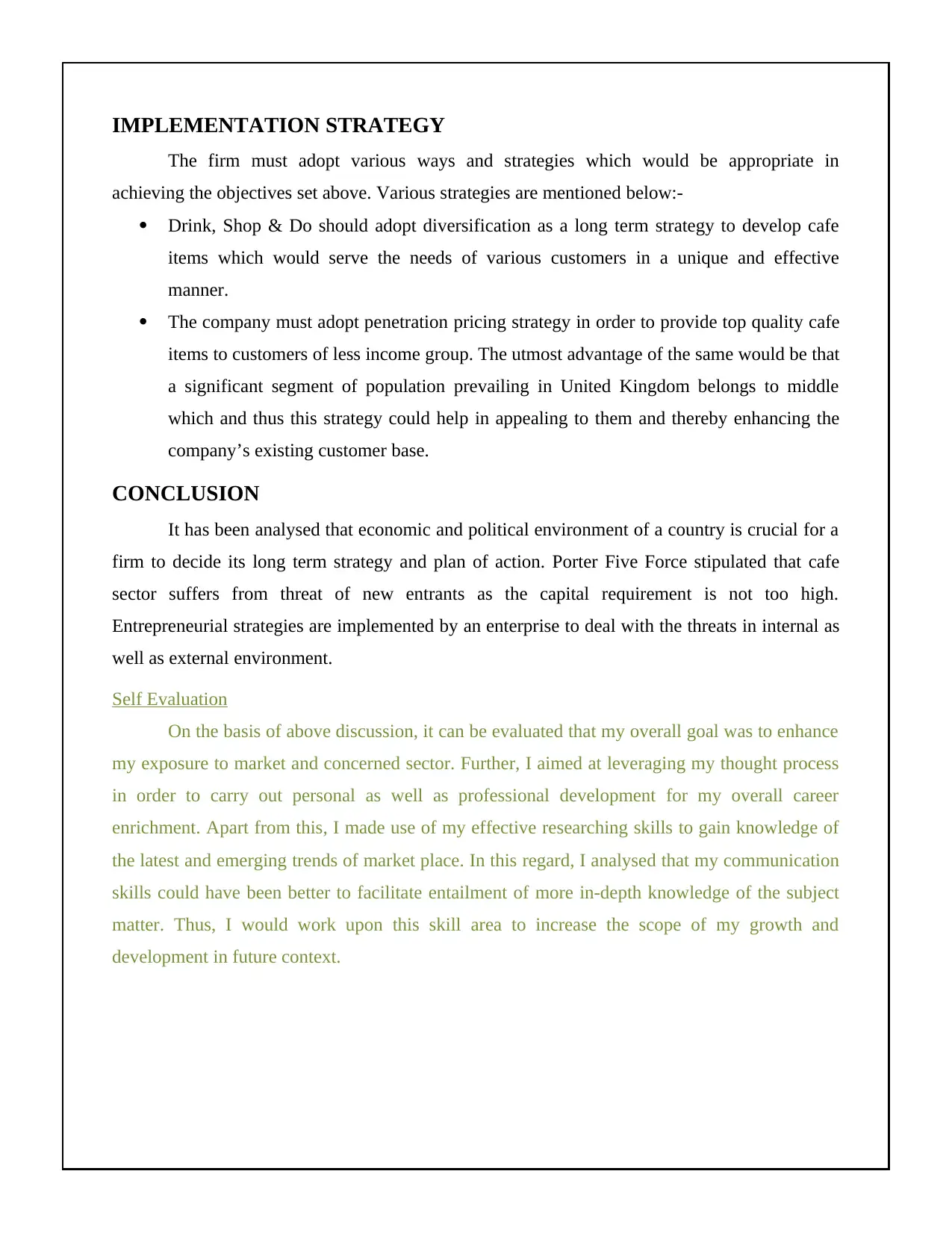
IMPLEMENTATION STRATEGY
The firm must adopt various ways and strategies which would be appropriate in
achieving the objectives set above. Various strategies are mentioned below:-
Drink, Shop & Do should adopt diversification as a long term strategy to develop cafe
items which would serve the needs of various customers in a unique and effective
manner.
The company must adopt penetration pricing strategy in order to provide top quality cafe
items to customers of less income group. The utmost advantage of the same would be that
a significant segment of population prevailing in United Kingdom belongs to middle
which and thus this strategy could help in appealing to them and thereby enhancing the
company’s existing customer base.
CONCLUSION
It has been analysed that economic and political environment of a country is crucial for a
firm to decide its long term strategy and plan of action. Porter Five Force stipulated that cafe
sector suffers from threat of new entrants as the capital requirement is not too high.
Entrepreneurial strategies are implemented by an enterprise to deal with the threats in internal as
well as external environment.
Self Evaluation
On the basis of above discussion, it can be evaluated that my overall goal was to enhance
my exposure to market and concerned sector. Further, I aimed at leveraging my thought process
in order to carry out personal as well as professional development for my overall career
enrichment. Apart from this, I made use of my effective researching skills to gain knowledge of
the latest and emerging trends of market place. In this regard, I analysed that my communication
skills could have been better to facilitate entailment of more in-depth knowledge of the subject
matter. Thus, I would work upon this skill area to increase the scope of my growth and
development in future context.
The firm must adopt various ways and strategies which would be appropriate in
achieving the objectives set above. Various strategies are mentioned below:-
Drink, Shop & Do should adopt diversification as a long term strategy to develop cafe
items which would serve the needs of various customers in a unique and effective
manner.
The company must adopt penetration pricing strategy in order to provide top quality cafe
items to customers of less income group. The utmost advantage of the same would be that
a significant segment of population prevailing in United Kingdom belongs to middle
which and thus this strategy could help in appealing to them and thereby enhancing the
company’s existing customer base.
CONCLUSION
It has been analysed that economic and political environment of a country is crucial for a
firm to decide its long term strategy and plan of action. Porter Five Force stipulated that cafe
sector suffers from threat of new entrants as the capital requirement is not too high.
Entrepreneurial strategies are implemented by an enterprise to deal with the threats in internal as
well as external environment.
Self Evaluation
On the basis of above discussion, it can be evaluated that my overall goal was to enhance
my exposure to market and concerned sector. Further, I aimed at leveraging my thought process
in order to carry out personal as well as professional development for my overall career
enrichment. Apart from this, I made use of my effective researching skills to gain knowledge of
the latest and emerging trends of market place. In this regard, I analysed that my communication
skills could have been better to facilitate entailment of more in-depth knowledge of the subject
matter. Thus, I would work upon this skill area to increase the scope of my growth and
development in future context.
Secure Best Marks with AI Grader
Need help grading? Try our AI Grader for instant feedback on your assignments.
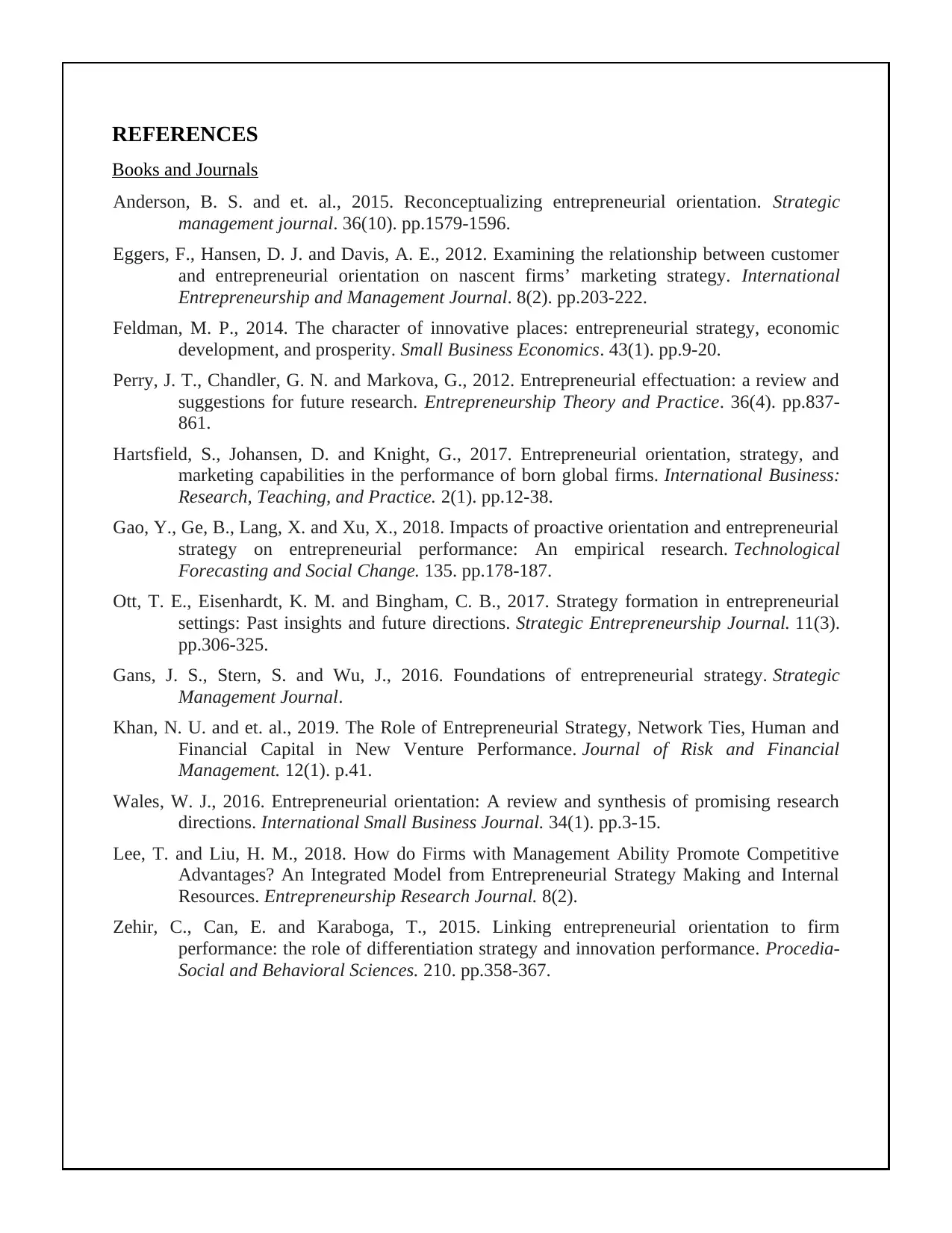
REFERENCES
Books and Journals
Anderson, B. S. and et. al., 2015. Reconceptualizing entrepreneurial orientation. Strategic
management journal. 36(10). pp.1579-1596.
Eggers, F., Hansen, D. J. and Davis, A. E., 2012. Examining the relationship between customer
and entrepreneurial orientation on nascent firms’ marketing strategy. International
Entrepreneurship and Management Journal. 8(2). pp.203-222.
Feldman, M. P., 2014. The character of innovative places: entrepreneurial strategy, economic
development, and prosperity. Small Business Economics. 43(1). pp.9-20.
Perry, J. T., Chandler, G. N. and Markova, G., 2012. Entrepreneurial effectuation: a review and
suggestions for future research. Entrepreneurship Theory and Practice. 36(4). pp.837-
861.
Hartsfield, S., Johansen, D. and Knight, G., 2017. Entrepreneurial orientation, strategy, and
marketing capabilities in the performance of born global firms. International Business:
Research, Teaching, and Practice. 2(1). pp.12-38.
Gao, Y., Ge, B., Lang, X. and Xu, X., 2018. Impacts of proactive orientation and entrepreneurial
strategy on entrepreneurial performance: An empirical research. Technological
Forecasting and Social Change. 135. pp.178-187.
Ott, T. E., Eisenhardt, K. M. and Bingham, C. B., 2017. Strategy formation in entrepreneurial
settings: Past insights and future directions. Strategic Entrepreneurship Journal. 11(3).
pp.306-325.
Gans, J. S., Stern, S. and Wu, J., 2016. Foundations of entrepreneurial strategy. Strategic
Management Journal.
Khan, N. U. and et. al., 2019. The Role of Entrepreneurial Strategy, Network Ties, Human and
Financial Capital in New Venture Performance. Journal of Risk and Financial
Management. 12(1). p.41.
Wales, W. J., 2016. Entrepreneurial orientation: A review and synthesis of promising research
directions. International Small Business Journal. 34(1). pp.3-15.
Lee, T. and Liu, H. M., 2018. How do Firms with Management Ability Promote Competitive
Advantages? An Integrated Model from Entrepreneurial Strategy Making and Internal
Resources. Entrepreneurship Research Journal. 8(2).
Zehir, C., Can, E. and Karaboga, T., 2015. Linking entrepreneurial orientation to firm
performance: the role of differentiation strategy and innovation performance. Procedia-
Social and Behavioral Sciences. 210. pp.358-367.
Books and Journals
Anderson, B. S. and et. al., 2015. Reconceptualizing entrepreneurial orientation. Strategic
management journal. 36(10). pp.1579-1596.
Eggers, F., Hansen, D. J. and Davis, A. E., 2012. Examining the relationship between customer
and entrepreneurial orientation on nascent firms’ marketing strategy. International
Entrepreneurship and Management Journal. 8(2). pp.203-222.
Feldman, M. P., 2014. The character of innovative places: entrepreneurial strategy, economic
development, and prosperity. Small Business Economics. 43(1). pp.9-20.
Perry, J. T., Chandler, G. N. and Markova, G., 2012. Entrepreneurial effectuation: a review and
suggestions for future research. Entrepreneurship Theory and Practice. 36(4). pp.837-
861.
Hartsfield, S., Johansen, D. and Knight, G., 2017. Entrepreneurial orientation, strategy, and
marketing capabilities in the performance of born global firms. International Business:
Research, Teaching, and Practice. 2(1). pp.12-38.
Gao, Y., Ge, B., Lang, X. and Xu, X., 2018. Impacts of proactive orientation and entrepreneurial
strategy on entrepreneurial performance: An empirical research. Technological
Forecasting and Social Change. 135. pp.178-187.
Ott, T. E., Eisenhardt, K. M. and Bingham, C. B., 2017. Strategy formation in entrepreneurial
settings: Past insights and future directions. Strategic Entrepreneurship Journal. 11(3).
pp.306-325.
Gans, J. S., Stern, S. and Wu, J., 2016. Foundations of entrepreneurial strategy. Strategic
Management Journal.
Khan, N. U. and et. al., 2019. The Role of Entrepreneurial Strategy, Network Ties, Human and
Financial Capital in New Venture Performance. Journal of Risk and Financial
Management. 12(1). p.41.
Wales, W. J., 2016. Entrepreneurial orientation: A review and synthesis of promising research
directions. International Small Business Journal. 34(1). pp.3-15.
Lee, T. and Liu, H. M., 2018. How do Firms with Management Ability Promote Competitive
Advantages? An Integrated Model from Entrepreneurial Strategy Making and Internal
Resources. Entrepreneurship Research Journal. 8(2).
Zehir, C., Can, E. and Karaboga, T., 2015. Linking entrepreneurial orientation to firm
performance: the role of differentiation strategy and innovation performance. Procedia-
Social and Behavioral Sciences. 210. pp.358-367.
1 out of 11
Related Documents
Your All-in-One AI-Powered Toolkit for Academic Success.
+13062052269
info@desklib.com
Available 24*7 on WhatsApp / Email
![[object Object]](/_next/static/media/star-bottom.7253800d.svg)
Unlock your academic potential
© 2024 | Zucol Services PVT LTD | All rights reserved.





